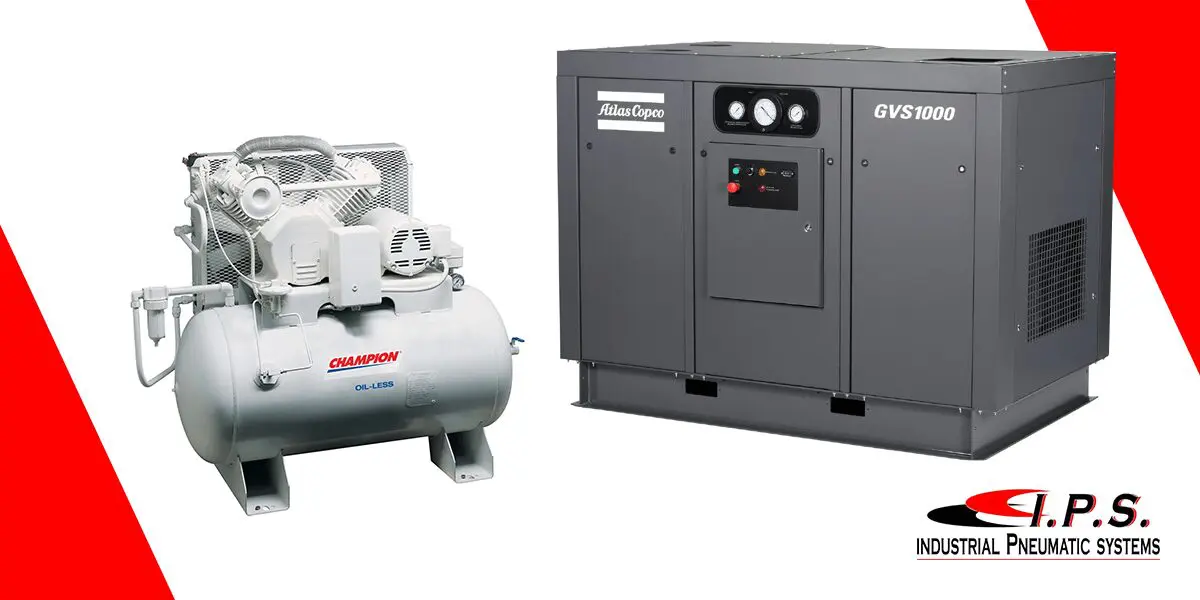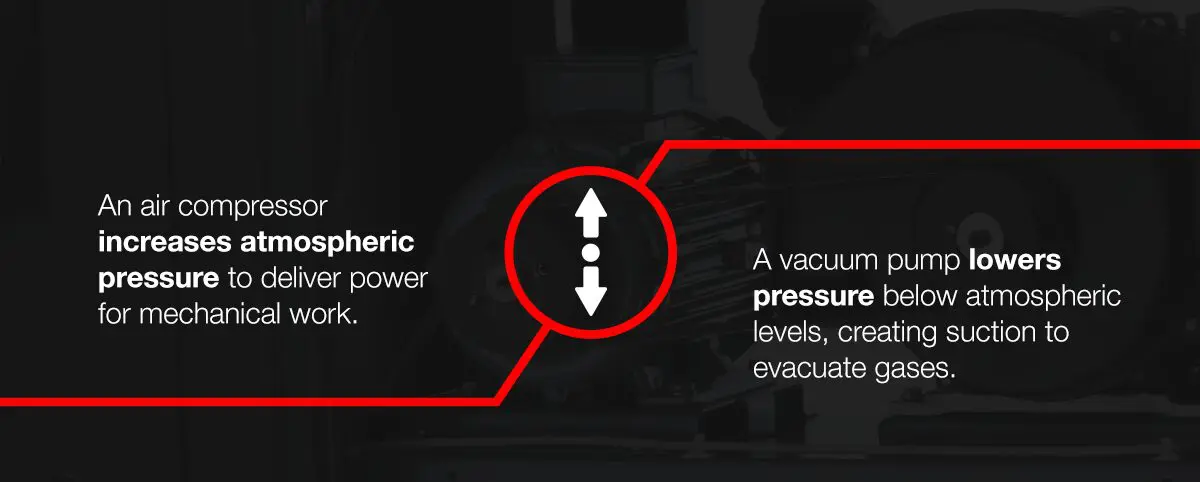
Air compressors and vacuum pumps serve distinct roles in industrial operations, yet both manipulate pressure to move air or gas. These technologies support critical systems, from manufacturing and food processing to healthcare and municipal services. Despite their shared mechanical principles, they function in fundamentally opposite ways.
This guide explains the difference between a vacuum pump and an air compressor, including their unique mechanisms, types and industrial use cases.
What Is an Air Compressor?
An air compressor is a machine that takes in atmospheric air, compresses it to a higher pressure and then delivers it for immediate use or stores it in a tank for later demand. This pressurized air becomes a versatile energy source, capable of powering pneumatic tools, supporting assembly lines, inflating products or maintaining facility operations. Selecting the right model requires balancing flow rate, pressure output, air purity requirements and duty cycle against a facility’s operational demands.
How Air Compressors Work
Air compressors operate under two main categories:
1. Positive Displacement
Positive displacement compressors work by mechanically reducing air volume within a sealed chamber. This compression increases the air’s pressure before releasing it through an outlet valve. Common types include:
- Rotary screw compressors: Rotary screw compressors use interlocking helical rotors to compress air continuously, offering reliability and steady flow for industrial-scale processes. They are ideal for large-scale operations thanks to their ability to deliver a continuous duty cycle and high flow rates.
- Piston compressors: Piston compressors, also known as reciprocating compressors, use a piston driven by a crankshaft inside a cylinder to compress air into a chamber. These are best suited for light manufacturing or repair shops requiring lower duty cycles.
- Diaphragm compressors: Diaphragm compressors employ a flexible diaphragm to compress air in a sealed chamber. This design delivers higher-purity air, making it suitable for sensitive industries like medical, food and beverage.
2. Dynamic
Dynamic compressors use rotating impellers to increase air velocity and then convert that velocity into pressure. Unlike positive displacement types, they can handle large volumes of air with a smoother flow profile. Common types include:
- Centrifugal compressors: Centrifugal compressors use radial impellers to accelerate air outward into a diffuser, where the kinetic energy is converted to pressure. They are well-suited for high-capacity applications in large industrial plants.
- Axial compressors: Though less common in standard industrial use, axial compressors compress air through rows of rotating and stationary blades (airfoils), causing the air to accelerate and then convert the kinetic energy into pressure. They are typically used in aerospace or power generation settings.
What Is a Vacuum Pump?
A vacuum pump is a mechanical device that removes air or gas molecules from a sealed system to create a pressure lower than atmospheric pressure. Unlike compressors, which work with positive pressure systems, vacuum pumps function under negative pressure. Their design varies depending on the level of vacuum required and the application’s operating conditions.
How Vacuum Pumps Work
Vacuum pumps create a pressure differential by removing air or gases from a confined space through one of two core operating principles:
1. Positive Displacement
Positive displacement vacuum pumps trap and expel volumes of air or gas to gradually reduce pressure. Common types include:
- Rotary vane vacuum pumps: Rotary vane vacuum pumps use a rotating mechanism with sliding vanes to trap air and push it toward an exhaust port. They are reliable for low- to medium-vacuum tasks in industrial settings.
- Screw vacuum pumps: These pumps consist of two parallel rotors that rotate in opposite directions to compress and remove gas. They offer a wide pressure range, lower noise output and energy efficiency, making them ideal for large-scale manufacturing and environmental control systems.
2. Dynamic
Momentum transfer pumps, also known as kinetic pumps, impart velocity to gas molecules using high-speed rotors, transferring them from the inlet to the outlet. Common types include:
- Turbomolecular pumps: Turbomolecular pumps use rapidly spinning impellers to accelerate air molecules and direct them out of the vacuum chamber, creating ultra-high vacuum for applications like semiconductor manufacturing.
- Diffusion pumps: Diffusion pumps create a high-speed vapor jet to sweep gas molecules out of the system, often used in high and ultra-high vacuum applications in controlled environments.

What Are the Main Differences Between Air Compressors and Vacuum Pumps?
Understanding the nuances of vacuum pumps vs. compressors can help businesses choose equipment suited to their specific processes. Here are the key differences:
- Fundamental purpose: An air compressor increases atmospheric pressure to deliver power for mechanical work. In contrast, a vacuum pump lowers pressure below atmospheric levels, creating suction to evacuate gases.
- Design and flow direction: In an air compressor, air moves from the atmosphere into the compressor and is then pressurized for downstream use. In a vacuum pump, air flows from the sealed system into the pump, then vents to the atmosphere or a treatment stage.
- Key metrics: Compressors are rated by tank volume measured in gallons, pressure output — typically between 90 and 120 pounds per square inch (PSI) or higher for industrial applications — and flow rate, measured in cubic feet per minute (CFM) or standard cubic feet per minute (SCFM). Vacuum pumps are evaluated based on their ability to reach a specific vacuum level, also known as absolute pressure, which is measured in pounds per square inch absolute (PSIA) and pumping speed.
- Storage requirements: Air compressors rely on pressurized storage tanks to maintain steady system pressure and accommodate sudden demand spikes. Vacuum pumps typically do not require storage tanks.
Can an Air Compressor Be Used as a Vacuum Pump?
An air compressor can be adapted to act as a vacuum pump by modifying its air intake and exhaust, but this requires significant changes and is not a simple plug-and-play solution. Alternatively, you can use a compressor with a venturi attachment to create a vacuum, though this method is less efficient and less powerful than a proper vacuum pump.
Applications of Air Compressors
Air compressors supply pressurized air for various industrial and commercial tasks in many sectors, including:
- Manufacturing: Air compressors power pneumatic tools, actuators, painting equipment and automated systems across assembly lines and production cells.
- Automotive: They are vital in assembly plants for fastening and painting, tire inflation, sanding and other tasks that require compressed air.
- Healthcare: Medical facilities depend on air compressors to operate surgical instruments such as handpieces, ventilators and sterilization systems.
- Food processing: Oil-free compressors maintain air purity during food packaging and filling, product handling and sorting, processing tasks like cutting and mixing, cleaning and drying of equipment and products, and during cooling and freezing.
- Municipalities: Cities and public utilities use air compressors in wastewater treatment plants, installing and repairing water and gas lines, facility maintenance systems and service vehicles that depend on mobile pneumatic tools.
Vacuum Pump Applications
Vacuum pumps enable precise environmental control and air removal in sealed systems. Their ability to generate negative pressure supports delicate and demanding processes across industrial sectors:
- Medical and dental: Vacuum pumps power surgical suction systems, aspiration units and dental evacuators in sterile medical settings.
- Food processing: They help seal food products in low-oxygen environments to preserve freshness, extend shelf life and improve presentation.
- Material handling: Vacuum pumps allow industrial plants to safely lift, grip and transport delicate or irregularly shaped items.
- Electronics: Semiconductor and circuit board manufacturers use vacuum pumps to create low-pressure and contaminant-free environments essential for precision processes such as PCB drying and vacuum soldering.
Contact Industrial Pneumatic Systems for Premium Air Compressors and Vacuum Pumps
Choosing an air pump vs. an air compressor comes down to understanding your operational needs. Compressors provide energy through high-pressure air, while vacuum pumps create controlled environments via negative atmospheric pressure. Both technologies are essential, but each serves different roles in industrial, commercial and medical settings.
At Industrial Pneumatic Systems, we deliver these technologies with expert guidance, technical support and a wide inventory of top-tier solutions. From rotary screw compressors to advanced vacuum pumps, we provide reliable systems that align with your performance goals.
Our team offers award-winning service, including free consultations, competitive pricing, repair and maintenance, installation and support to help you determine the right equipment for your applications. Contact us today to request a quote or schedule a free consultation with our technical specialists.

